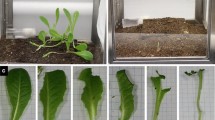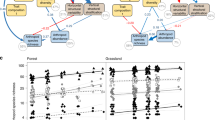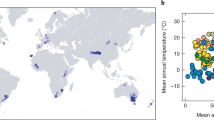Abstract
Changes in predator species richness can have important consequences for ecosystem functioning at multiple trophic levels, but these effects are variable and depend on the ecological context in addition to the properties of predators themselves. Here, we report an experimental study to test how species identity, community attributes, and community structure at the herbivore level moderate the effects of predator richness on ecosystem functioning. Using mesocosms containing predatory insects and aphid prey, we independently manipulated species richness at both predator and herbivore trophic levels. Community structure was also manipulated by changing the distribution of herbivore species across two plant species. Predator species richness and herbivore species richness were found to negatively interact to influence predator biomass accumulation, an effect which is hypothesised to be due to the breakdown of functional complementarity among predators in species-rich herbivore assemblages. The strength of predator suppression of herbivore biomass decreased as herbivore species richness and distribution across host plants increased, and positive predator richness effects on herbivore biomass suppression were only observed in herbivore assemblages of relatively low productivity. In summary, the study shows that the species richness, productivity and host plant distribution of prey communities can all moderate the general influence of predators and the emergence of predator species richness effects on ecosystem functioning.





Similar content being viewed by others
References
Asiry KAM (2010) The impacts of cereal-legume intercropping on biological control of cereal aphids within temperate agro-ecosystems. PhD thesis, School of Agriculture Policy and Development, University of Reading, Reading
Byrnes JE, Stachowicz JJ (2009) The consequences of consumer diversity loss: different answers from different experimental designs. Ecology 90:2879–2888
Cardinale BJ et al (2006a) Effects of biodiversity on the functioning of trophic groups and ecosystems. Nature 443:989–992
Cardinale BJ, Weis JJ, Forbes AE, Tilmon KJ, Ives AR (2006b) Biodiversity as both a cause and consequence of resource availability: a study of reciprocal causality in a predator–prey system. J Anim Ecol 75:497–505
Casula P (2006) Evaluating hypotheses about dispersal in a vulnerable butterfly. Ecol Res 21:263–270
Crawley MJ (2007) The R Book. Wiley, Chichester
Douglass JG, Duffy JE, Bruno JF (2008a) Herbivore and predator diversity interactively affect ecosystem properties in an experimental marine community. Ecol Lett 11:598–608
Douglass JG, Duffy JE, Bruno JF, Gilchrist GW (2008b) Correction of statistical miscalculation slightly alters conclusions about diversity effects for Douglass et al. (2008). Ecol Lett 11:E9–E10
Duffy JE (2003) Biodiversity loss, trophic skew and ecosystem functioning. Ecol Lett 6:680–687
Duffy JE, Richardson J, Canuel E (2003) Grazer diversity effects on ecosystem functioning in seagrass beds. Ecol Lett 6:637–645
Evans EW (1991) Intra versus interspecific interactions of ladybeetles (Coleoptera, Coccinellidae) attacking aphids. Oecologia 87:401–408
Finke DL, Denno RF (2005) Predator diversity and the functioning of ecosystems: the role of intraguild predation in dampening trophic cascades. Ecol Lett 8:1299–1306
Finke DL, Snyder WE (2008) Niche partitioning increases resource exploitation by diverse communities. Science 321:1488–1490
Finke DL, Snyder WE (2010) Conserving the benefits of predator biodiversity. Biol Conserv 143:2260–2269
Gamfeldt L, Hillebrand H, Jonsson PR (2005) Species richness changes across two trophic levels simultaneously affect prey and consumer biomass. Ecol Lett 8:696–703
Griffen BD, Byers JE (2006) Intraguild predation reduces redundancy of predator species in multiple predator assemblage. J Anim Ecol 75:959–966
Griffiths GJK, Wilby A, Crawley MJ, Thomas MB (2008) Density-dependent effects of predator species-richness in diversity–function studies. Ecology 89:2986–2993
Hassel M (1981) Arthropod predator–prey systems In: May R (ed) Theoretical ecology: principles and applications. Blackwell, Oxford, pp 105–131
Hector A, von Felten S, Schmid B (2010) Analysis of variance with unbalanced data: an update for ecology & evolution. J Anim Ecol 79:308–316
Hillebrand H, Cardinale BJ (2004) Consumer effects decline with prey diversity. Ecol Lett 7:192–201
Huston MA (1997) Hidden treatments in ecological experiments: re-evaluating the ecosystem function of biodiversity. Oecologia 110:449–460
Ives AR, Cardinale BJ (2004) Food-web interactions govern the resistance of communities after non-random extinctions. Nature 429:174–177
Jonsson M, Johansson F, Karlsson C, Brodin T (2007) Intermediate predator impact on consumers weakens with increasing predator diversity in the presence of a top-predator. Acta Oecol Int J Ecol 31:79–85
Kalushkov P (1999) The effect of aphid prey quality on searching behaviour of Adalia bipunctata and its susceptibility to insecticides. Entomol Exp Appl 92:277–282
Letourneau DK, Jedlicka JA, Bothwell SG, Moreno CR (2009) Effects of natural enemy biodiversity on the suppression of arthropod herbivores in terrestrial ecosystems. Annu Rev Ecol Evol Syst 40:573–592
Loreau M (2004) Does functional redundancy exist? Oikos 104:606–611
Loreau M, Mouquet N, Gonzales A (2003) Biodiversity as spatial insurance in heterogeneous landscapes. Proc Natl Acad Sci USA 100:12765–12770
Losey JE, Denno RF (1998) Positive predator–predator interactions: enhanced predation rates and synergistic suppression of aphid populations. Ecology 79:2143–2152
McKinney ML (1997) Extinction vulnerability and selectivity: combining ecological and paleontological views. Annu Rev Ecol Syst 28:495–516
Narwani A, Mazumder A (2010) Community composition and consumer identity determine the effect of resource species diversity on rates of consumption. Ecology 91:3441–3447
Northfield TD, Snyder GB, Ives AR, Snyder WE (2010) Niche saturation reveals resource partitioning among consumers. Ecol Lett 13:338–348
O’Gorman EJ, Enright RA, Emmerson MC (2008) Predator diversity enhances secondary production and decreases the likelihood of trophic cascades. Oecologia 158:557–567
R Development Core Team (2007). R: a language and environment for statistical computing. R Foundation for Statistical Computing, Vienna. Austria. (http://www.r-project.org)
Rana JS, Dixon AFG, Jarosik V (2002) Costs and benefits of prey specialization in a generalist insect predator. J Anim Ecol 71:15–22
Schellhorn NA, Andow DA (2005) Response of coccinellids to their aphid prey at different spatial scales. Popul Ecol 47:71–76
Schmitz OJ, Hamback PA, Beckerman AP (2000) Trophic cascades in terrestrial systems: a review of the effects of carnivore removals on plants. Am Nat 155:141–153
Snyder GB, Finke DL, Snyder WE (2008) Predator biodiversity strengthens aphid suppression across single- and multiple-species prey communities. Biol Control 44:52–60
Straub CS, Finke DL, Snyder WE (2008) Are the conservation of natural enemy biodiversity and biological control compatible goals? Biol Control 45:225–237
Tylianakis JM, Romo CM (2010) Natural enemy diversity and biological control: making sense of the context-dependency. Basic Appl Ecol 11:657–668
Vance-Chalcraft HD, Soluk DA, Ozburn N (2004) Is prey predation risk influenced more by increasing predator density or predator species richness in stream enclosures? Oecologia 139:117–122
Wilby A, Thomas MB (2002a) Are the ecological concepts of assembly and function of biodiversity useful frameworks for understanding natural pest control? Agric For Entomol 4:237–243
Wilby A, Thomas MB (2002b) Natural enemy diversity and natural pest control: patterns of pest emergence with agricultural intensification. Ecol Lett 5:353–360
Wilby A, Thomas MB (2007) Diversity and pest management in agro-ecosystems—some perspectives from ecology. In: Jarvis DI, Padoch C, Cooper HD (eds) Managing biodiversity in agricultural ecosystems. Columbia University Press, New York, pp 225–269
Wilby A, Villareal S, Lan L, Heong K, Thomas M (2005) Functional benefits of predator species diversity depend on prey identity. Ecol Entomol 30:497–501
Wojdak JM, Luttbeg B (2005) Relative strengths of trait-mediated and density-mediated indirect effects of a predator vary with resource levels in a freshwater food chain. Oikos 111:592–598
Worm B, Duffy JE (2003) Biodiversity, productivity and stability in real food webs. Trends Ecol Evol 18:628–632
Acknowledgments
We thank Carys Hutton, Liz Wheeldon and Matt Naish for their considerable efforts in helping us run these experiments, and to two anonymous reviewers for their constructive criticism of the paper. This work was funded by the NERC project NE\G010226\1 awarded to A. Wilby and K. Orwin.
Author information
Authors and Affiliations
Corresponding author
Additional information
Communicated by Jason Tylianakis.
Rights and permissions
About this article
Cite this article
Wilby, A., Orwin, K.H. Herbivore species richness, composition and community structure mediate predator richness effects and top-down control of herbivore biomass. Oecologia 172, 1167–1177 (2013). https://doi.org/10.1007/s00442-012-2573-8
Received:
Accepted:
Published:
Issue Date:
DOI: https://doi.org/10.1007/s00442-012-2573-8




